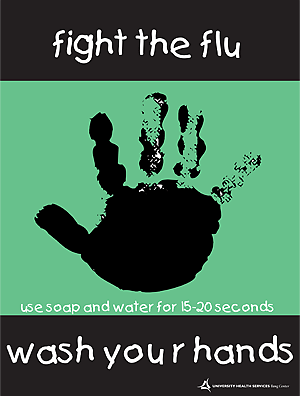H1N1: Intruder at the gates
The campus gets ready for flu
| 10 September 2009
BERKELEY — A campus team led by University Health Services (UHS) is preparing for the arrival at Berkeley of an unwanted visitor: H1N1 influenza. First called swine flu, H1N1 flu has already gotten a toehold in Northern California and is expected to hit schools and colleges this fall. Because of the possibility that large numbers within the campus community could be affected, officials here have been planning actively for the fall semester since the initial H1N1 outbreak in April.
The flu, whose spread the Centers for Disease Control and Prevention (CDC) is calling a pandemic, travels from human to human. Fortunately, at this point the severity of illness caused by the H1N1 virus is mild in most people.
 Campus H1N1 resources: E-mail, online, and in person
Campus H1N1 resources: E-mail, online, and in personCal Messages to keep the campus updated on H1N1 influenza will be sent to faculty, staff, and other campus groups as circumstances warrant during the flu season. Current information is available online on the UC Berkeley NewsCenter's flu-resource page. From there, click on "Flu resources and FAQ (UHS)" to get to the University Health Services page with information and links to additional resources, such as the Centers for Disease Control and the World Health Organization.
Health*Matters, the campus Wellness Program for Faculty and Staff, is offering interactive flu-prevention education in campus departments and work groups; materials can be customized to fit department needs. The workshop covers an interactive hand-washing exercise, coughing etiquette, and tips on staying healthy.
To schedule a customized session, contact Kristl Buluran at 643-9082 or visit Health*Matters H1N1 Prevention Workshops.
To protect the health of students, faculty, and staff, UHS has teamed up with contagious-disease and flu experts from the School of Public Health, the city of Berkeley's public-health office, and campus representatives from housing and dining, academic services, recreational sports, and human resources.
"Active and concerted prevention efforts are going to be key to limiting the impact of this illness on our students and on campus operations as a whole," says Brad Buchman, medical director of University Health Services. "We have pulled together key campus departments and incorporated guidance from the UCOP Pandemic Advisory Board to help us prepare for what could potentially be a significant burden of illness on campus in the upcoming months."
An ounce of prevention
Preventive measures will help ward off the H1N1 flu. Two simple actions (both recommended by UHS) are washing your hands frequently and coughing into your sleeve. The campus is focusing prevention efforts at locations where the H1N1 flu could spread rapidly, including residence halls, dining halls, and the Recreational Sports Facility.
Signs that you're coming down with the flu include a sudden spike in temperature and a cough, says Buchman, while noting that it's not easy to differentiate between seasonal and H1N1 varieties based on symptoms. In either case, he says, the CDC recommends "self-isolation" — staying home — until 24 hours after your temperature has returned to normal.
In addition to its annual seasonal-flu clinic, this year the Tang Center will provide H1N1 vaccinations — though the targeted vaccine won't arrive until late October. (Seasonal-flu-vaccine clinics will start as soon as that vaccine is received in the latter half of September.) UHS has forwarded its H1N1-vaccine request to the California Department of Public Health, based on estimates of campus population groups at highest risk, which include students, faculty, and staff with underlying medical conditions; the large percentage of students and staff between the ages of 18 and 24 years old; and health workers and emergency-preparedness personnel.
In addition to campus-wide prevention efforts and vaccination, UHS and other departments are planning for the possibility that the illness could become significantly widespread at Berkeley, and for the more remote possibility that the illness caused by the H1N1 virus could become more severe.


 Campus resources and responses
Campus resources and responses